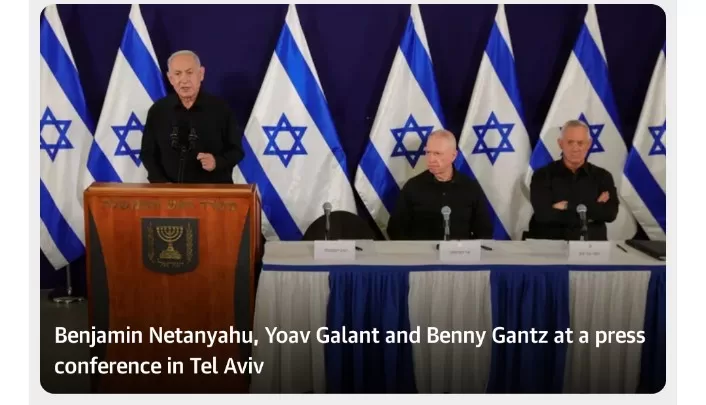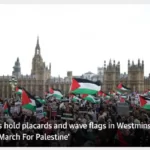On Saturday night, Gaza bore witness to a grim transformation, descending into a state of darkness, isolation, and escalating violence. The enclave found its communications with the outside world nearly severed, as Israel’s Prime Minister, Benjamin Netanyahu, declared the initiation of what appears to be a protracted and challenging war against Hamas, marking a pivotal moment in the conflict.
In a nationally televised press conference, Netanyahu addressed the Israeli population with a resolute message: “We have unanimously sanctioned the expansion of our ground invasion. Our sole objective is clear: the defeat of the belligerent adversary. We declared ‘never again,’ and we emphasize that ‘never again’ is now.”
Netanyahu described this broadening of the conflict as Israel’s “second war of independence.” He elaborated, “In the initial weeks of this war, we conducted extensive airstrikes, which inflicted significant damage upon our adversary. We eliminated numerous terrorists. Nevertheless, this marks just the commencement. The battle within the Gaza Strip will be arduous and prolonged; this is our second struggle for independence.”
As the 2.3 million Palestinians within the besieged coastal strip braced themselves for a second night of intensifying Israeli military operations, Israel’s Defense Minister, Yoav Gallant, declared that the campaign against the Islamist militant group Hamas would persist until further orders were issued.
Following the most relentless wave of airstrikes witnessed thus far in this conflict, involving up to 100 Israeli aircraft striking numerous targets throughout the previous night, Israeli armored forces and infantry remained engaged in combat within Gaza under the cover of darkness.
Netanyahu’s statements closely followed remarks by Gallant and the IDF Chief of Staff, Herzi Halevi, both indicating that the war had entered a new phase. Halevi, at the helm of the Israel Defense Forces (IDF), announced that the objectives of the conflict against Hamas necessitated a ground operation within the coastal strip. He stated, “IDF ground forces are executing a significant and intricate operation. Achievements invariably come with inherent risks, and, as we are aware, victories require sacrifices. To confront the enemy and dismantle it, we have no alternative but to forcefully enter their territory. This operation aligns with the overarching goals of this conflict.”
With virtually all links to mobile networks, the internet, and electricity severed within Gaza, emergency services, including paramedic teams, found themselves operating in the dark as they struggled to respond to numerous casualties caused by the airstrikes.
Certain civilians resorted to manual efforts to extricate injured individuals from the rubble, loading them into vehicles or donkey-drawn carts to rush them to medical facilities.
The conflict was set in motion after hundreds of Hamas fighters infiltrated the Israeli border by land, air, and sea on October 7th, indiscriminately targeting civilians in streets, homes, and an outdoor gathering.
Lynn Hastings, the UN humanitarian coordinator for the Palestinian territories, took to social media, asserting, “Hospitals and humanitarian operations cannot function without communication.” Meanwhile, Elon Musk, the owner of X, previously known as Twitter, extended an offer to supply internationally recognized agencies in Gaza with his Starlink satellite system. Amid mounting global concern over civilian casualties, the IDF reported striking 150 underground Hamas targets in Gaza overnight on Friday, while Palestinian residents reported skirmishes with Israeli armored units and infantry in three locations within the Gaza Strip.
Rocket launches from Gaza into Israel persisted, and exchanges of fire also erupted on Israel’s northern border with Lebanon, following the launch of anti-tank guided missiles and mortars toward Israeli towns and military positions. The latest airstrikes coincided with the IDF’s repeated calls for residents of northern Gaza to relocate south of Wadi Gaza, disseminated via leaflets dropped from aircraft.
With communication channels severed, scant reports from Gaza depicted scenes of overwhelmed hospitals and mortuaries on the brink of collapse, as terrified civilians grappled with uncertainty.
In a plea for a humanitarian ceasefire, the World Health Organization (WHO) expressed grave concerns, having lost contact with its personnel. Reports revealed horrifying conditions at hospitals, with WHO stating, “During a night of intense bombardment and ground incursions in Gaza, with hostilities apparently ongoing, health professionals, patients, and civilians have been plunged into a complete communication and electrical blackout. Reports of bombardment near the Indonesia and al-Shifa hospitals are highly distressing. WHO reiterates that evacuating patients without imperiling their lives remains an impossibility.”
The statement continued, “Gaza’s hospitals are already functioning at maximum capacity due to the injuries sustained during weeks of ceaseless bombardment, rendering them incapable of accommodating a significant surge in patients while sheltering thousands of civilians. Healthcare workers, steadfastly attending to their patients, are grappling with dwindling supplies, an absence of space for new patients, and no recourse to alleviate their patients’ suffering.”
The dire situation in Gaza was underlined by a warning from the UN’s human rights chief, Volker Türk, of the “potentially catastrophic consequences” of large-scale ground operations in the Gaza Strip, potentially leading to thousands more casualties.
A Gaza civil defense official lamented, “A large number of martyrs and survivors remain trapped beneath the debris, and we cannot reach them.” Raed al-Astal, a respiratory physician, conveyed a bleak picture: “The stench of death pervades every corner – every neighborhood, every street, and every house.”
The Hamas-administered Palestinian health ministry claimed that around 7,700 people in Gaza had lost their lives since October 7, following Hamas’s reported killing of approximately 1,400 Israelis residing along the Gaza border. These numbers, as claimed by Hamas, remain unverified.
On Saturday, the Israeli military released grainy images depicting tank columns maneuvering slowly in open areas of Gaza, many in close proximity to the border. Army spokesman R. Adm Daniel Hagari emphasized, “Our forces remain firmly on the ground, relentlessly pursuing the conflict.”
Reports from Gaza residents suggested that the most intense confrontations were occurring in the northern part of the Gaza Strip, particularly in the Beit Lahia and Beit Hanoun areas. Combat was also reported to the east of Bureij in central Gaza and to the east of Khan Younis, commonly used as access routes for Israeli incursions.
Witnesses conveyed that bombing had been concentrated in Gaza’s northern Jabalia district, resulting in streets pockmarked with craters and numerous buildings leveled.
The recent airstrikes targeting Gaza’s extensive Hamas tunnel network, referred to by Israeli military planners as the “metro,” align with accounts from released hostage Yocheved Lifshitz, 85, who recounted being taken deep into the tunnels, along with other captives, during her captivity.
Wafaa Abdul Rahman, the director of a feminist organization in Ramallah in the West Bank, expressed profound concern, having not received any communication for hours from her family trapped in central Gaza. She remarked, “We have witnessed these harrowing events and massacres as they unfolded live on television. What will occur when there’s a complete blackout?” Alluding to the tragic scenes of families buried in the wreckage of their homes due to airstrikes over recent weeks, she posed a haunting question about the unknown future.






